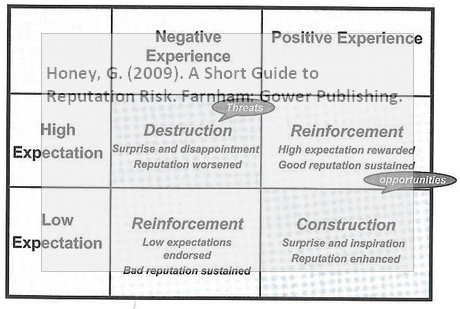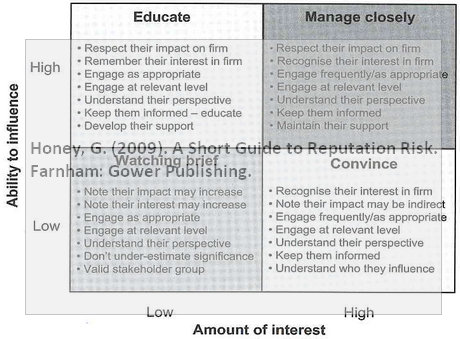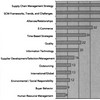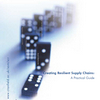 Reputation. Not only is it practically impossible to measure, its value is also frequently underestimated. Anything that can devalue your reputation is a reputation risk, and reputation risk and supply chain risk go hand in hand. Why? Because whatever happens in your supply chain may affect your reputation, and what affects your reputation will ultimately affect your business. A short Guide to Reputation Risk by Garry Honey describes how difficult it is to build a reputation, and how easy it is to destroy, how it can be measured, how it can be managed, what drives it and how different stakeholders focus on different aspects of reputation, and how reputation risk management is an integral part of overall risk management. All this is packed into one small book.
Reputation. Not only is it practically impossible to measure, its value is also frequently underestimated. Anything that can devalue your reputation is a reputation risk, and reputation risk and supply chain risk go hand in hand. Why? Because whatever happens in your supply chain may affect your reputation, and what affects your reputation will ultimately affect your business. A short Guide to Reputation Risk by Garry Honey describes how difficult it is to build a reputation, and how easy it is to destroy, how it can be measured, how it can be managed, what drives it and how different stakeholders focus on different aspects of reputation, and how reputation risk management is an integral part of overall risk management. All this is packed into one small book.
Business Risks
A Short Guide to Reputation Risk is my second review of the books in the Gower Short Guides to Business Risk series. The series covers topics such as reputation risk, political risk, fraud risk, ethical risk and customs risk, and with more topics on the bedding: operational risk, compliance risk, kidnap and ransom risk, corruption risk, equality risk and how to facilitate risk management. Since most of them, if not all, tie in nicely with supply chain risk, I’ve decided to work my way through all the books, something that will keep me busy for a considerable time, and ensure that I will not run out of topics to blog about.
What is so important about reputation?
This is a book that grows on you. While A Short Guide to Procurement Risk captures the reader right from the very first page, this book is off to a slow start. The first chapter doesn’t hit home immediately, albeit the second chapter makes up for that, and I will get to that in a moment. However, the first chapter does conclude with an essential description of what reputation is and what it means:
Reputation is something you are given by others, you do not choose it, others assign it to you so its quality is a reflection of how they see you. You can of course influence how others see you by your behaviour, but your reputation is earned as a consequence of actions. It is a secondary feature that can become part of your identity among stakeholder.
Reputation is earned by what you do, and how you do it, and nothing holds more true than walking the walk after talking the talk. Honey demonstrates this point brilliantly when he illustrates how experience and expectations link up with reputation:

Perhaps you should learn to walk before you start to talk? Reputation sits in the gap between expectation and performance. Where expectations are too high or too low, reputation is likely to suffer, and the reaction of the stakeholders is somewhere between disappointment at best and outrage at worst. That is the risk that has to be managed.
Causes and Impact of Reputation Risk
The second chapter is perhaps my favorite chapter of this book. According to Honey, there are six causes of damage to reputation: Legal, Ethical, Executive, Operations, Associations and Environment, as illustrated below.

Note the risk classification: Risks to avoid, risks to manage and risks to mitigate. Honey follows the classic four risk handling strategies, except for the fourth strategy, risks to transfer. Reputation risks cannot be transferred, outsourced or insured against. You simply have to deal with them. Also note that your reputation stems from the values you uphold and that reputation risks are caused by value misalignment (internal causes) or value conflict (external causes). I’m really impressed how Honey manages to tie all this together.
Stakeholders
Chapter 3 takes a look at stakeholders. Stakeholders are important when it comes to reputation. Like it or not, it’s the stakeholders perception that determines your reputation, and it is your communication with your stakeholders that influences their perception:

Stakeholder identification and appreciation is essential for reputation management. While primary stakeholders may seem most important in the first round, secondary stakeholders should not be neglected, as they may become critical (pun intended) in the next round.
Tools and controls
Different stakeholders will value different aspects differently, and in chapter 4 Honey identifies seven key drivers among the different stakeholders. I find it interesting to see that he uses an almost supply chain risk like perspective, with a supply side, a demand side, an internal side and an environmental side, much like the SCOR supply chain risk management framework in or in Martin Christopher’s book chapter on supply chain risk.

In measuring reputation risk it is necessary to keep in mind that reputation has a value that escapes monetary terms. The only way to measure reputation risk and to check whether your company is at risk is to identify, if any, the gap between expectations and performance.
Responsibility
One of the downsides to risk management is that risk is very fragmented, as in Hamilton’s Circle of Risk. Different risks affect different business areas differently, with every business area and its associated risks under the responsibility of a certain person or manager. Few organizations, however, are yet clear about who should be responsible for reputation risk. Honey advocates that the reputation of an organization should be the shared responsibility among all employees, as each is an ambassador in the eyes of the stakeholders. The difficulty lies in achieving a commitment to reputation by each and every employee, it is not just a matter for the Communications or Public Relations department.
Integrating Reputation Risk
There is no simple way to manage reputation risk, Honey says in chapter 6, and awareness of the impact on reputation should be an implicit part of any business decision. The aim must be to prevent a situation where damage to the reputation can occur, but how? Which business unit should be in charge? The Board of directors? The Risk management department? The Human resources department? The communications department. Whichever you choose, two distinct strategies must be kept in mind: a reputation protection strategy and a reputation enhancement strategy, and Honey cites clear examples of what reactive protection and proactive enhancement strategies entail and how they can be used by a manufacturer, a retailer, a professional firm and a public sector organization.
Governance and Compliance
Governance and compliance is more than just knowing when at what to report or disclose or to provide just enough transparency to satisfy regulations. Chapter 7 is about knowing why you should report – to inform, to inspire, to spread confidence. Confidence is what attracts and keeps investors, customers and employees. Transparency in reporting should be viewed as a competitive advantage, not as chore or worse, as a threat to business. Here Honey shows what should be included in Best Practice reporting, which needs to be based on understanding three essential ingredients: 1) all stakeholder groups 2) all building blocks of a company’s reputation, and 3) all reputation risks (both threats and opportunities) must be recognized acknowledged and appreciated.
Case studies
Chapter 8 contains six case studies, three from the public sector and three from the private sector:
- Identify and Passport Service – Home Office
- Should the UK introduce identity cards? Issue: Data collection and privacy against increased security.
- Hampshire County Council
- Should local authorities place reputation on their corporate risk register? Issue: With whom and why does a county council need good reputation?
- BBC
- Publicly funded, and thus publicly controlled? Issue: offensive and/or controversial programs, audience versus production team preferences.
- British Airways
- Opening of terminal 5 at London Heathrow. Issue: Major logistical challenges and outraged passengers.
- Severn Trent Water
- Privatised water services. Issue: Price increases justified using falsified evidence.
- BAE Systems
- Weapons deals with Saudi Arabia. Issue: Allegations of government intervention to call off investigations into unethical conduct.
While these case studies are obviously written with the British public in mind, they still carry international relevance, and show the wide spectrum of potential reputation risks, how they were handled and how they could have been handled in a perhaps more convincing manner. This approach is quite different from the Harvard Business Review on Crisis Management.
Conclusion
The fact that Garry Honey is founder of Chiron, a strategic communications agency, is evident throughout the book. He knows how to communicate and how to turn a complex matter into easy-to-understand figures and diagrams, as I have shown above. What you see above is just a small glimpse of the many illustrations in this book. That – in my opinion – is the most useful part of this book, and makes it as applicable in boardroom presentations drawing up strategies as it is in shopfloor workshops instigating the value of reputation into each and every member of the staff. This is not just a book, it is a set of tools. Perhaps I’m carried away here, but I really did enjoy reading this book.
Reference
Honey, G. (2009) A Short Guide to Reputation Risk. Farnham: Gower Publishing
Author link
- chironrisk.co.uk: Garry Honey
Publisher link
- gowerpublishing.com: A Short Guide to Reputation Risk
- gowerpublishing.com: A Short Guide to Reputation Risk (Chapter 1)
Buy this book
- amazon.com: A Short Guide to Reputation Risk
Related posts
- husdal.com: Book review – Political Risk
- husdal.com: Book review – Customs Risk
- husdal.com: Book review – Procurement Risk











